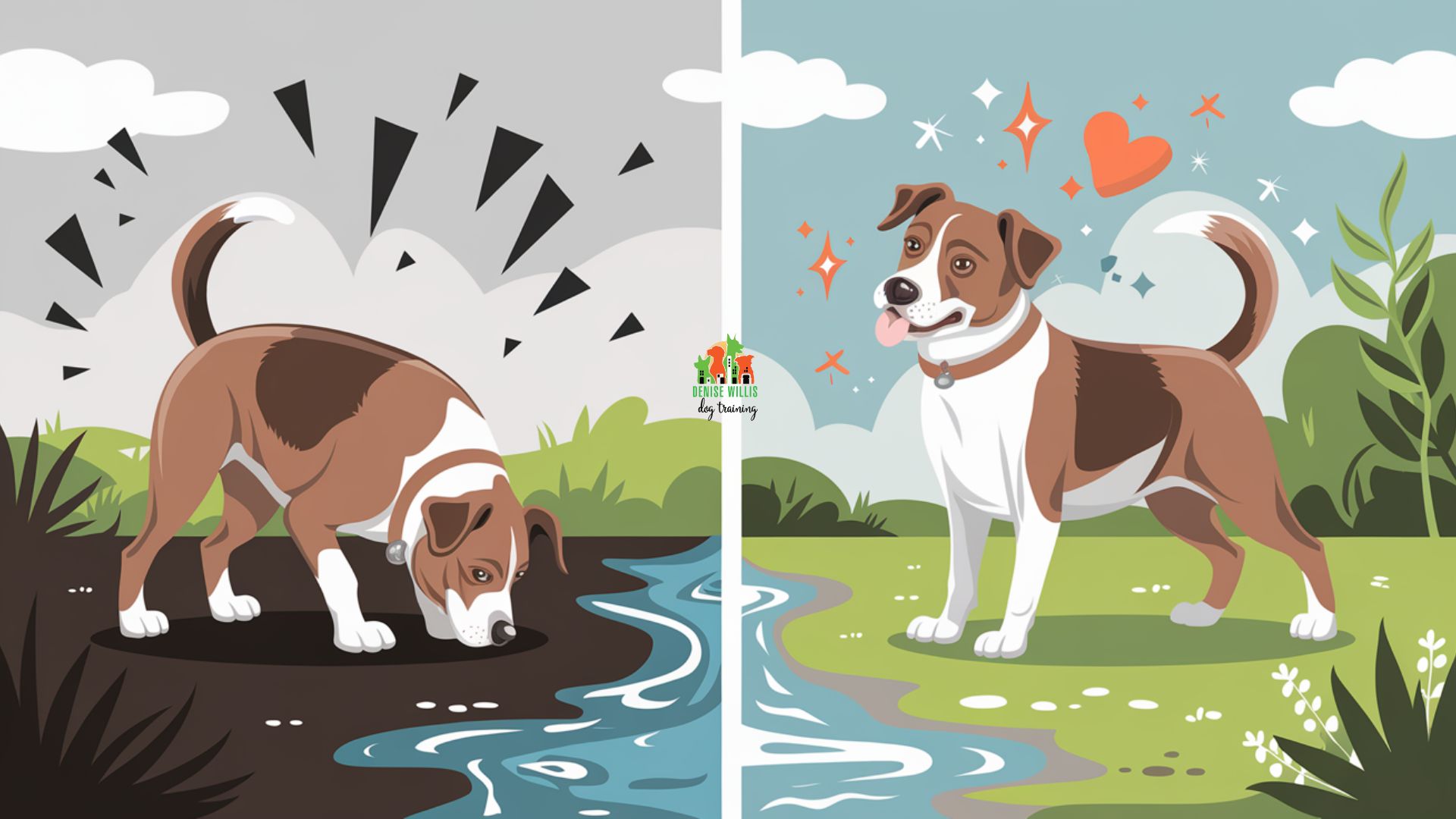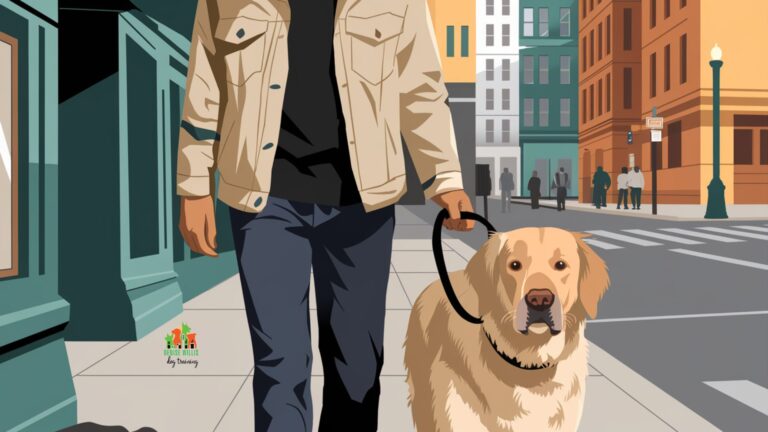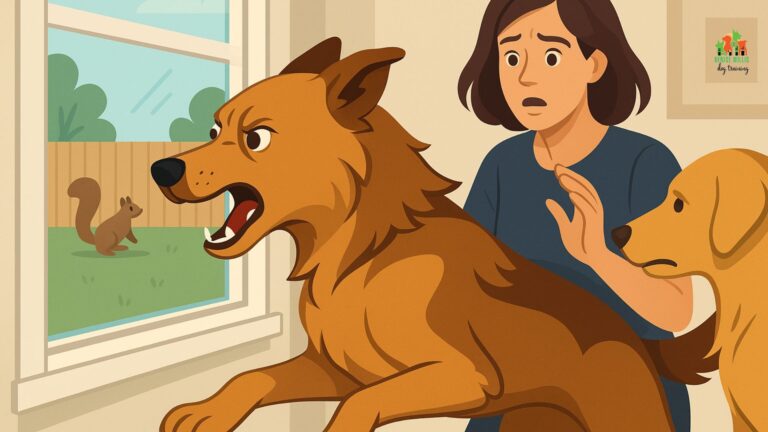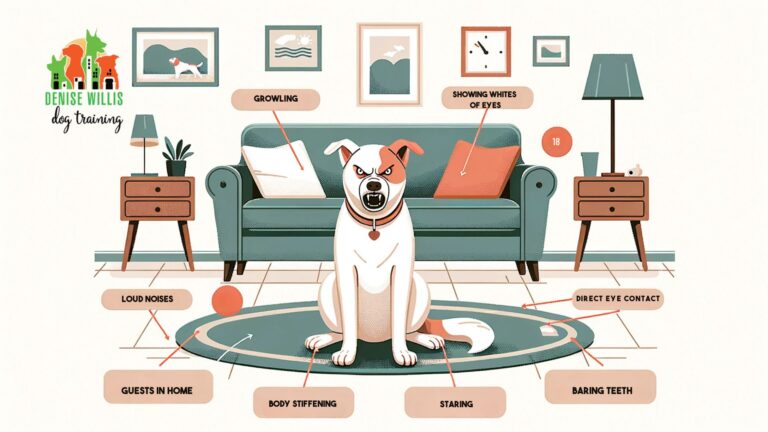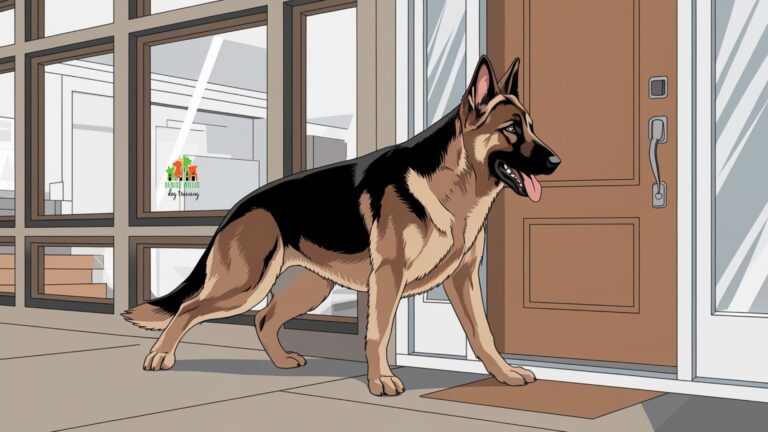Second Chances: Addressing Aggression in Rescue Dogs
📍 Service Area Notice: DW Dog Training provides in-person training services exclusively in the Greater Baltimore area. While our blog content is designed to help dog owners internationally, our hands-on training services are locally focused. For readers outside our service area, we hope you find value in our articles and welcome you to reach out with questions!
Imagine you’ve just brought home your new rescue dog, imagining peaceful walks and cozy Netflix marathons together. Instead, you’re googling “Why does my dog growl at the TV remote” at 2 AM.
Sound familiar?
Take a deep breath. You’re about to join a surprisingly large club of dedicated pet parents navigating the complex world of rescue dog rehabilitation.
According to recent studies highlighted by ManyPets, a significant number of rescue dogs show some form of aggressive behavior in their first months at home. But here’s the plot twist that’ll make your day: with understanding, patience, and the right approach, these same dogs often become the most loyal, loving companions you could ask for.
Building Blocks of Success
Before we dive into the nitty-gritty details of rescue dog rehabilitation, let’s look at the big picture. Think of these as your four cornerstones of success – kind of like the secret ingredients in your grandmother’s legendary cookie recipe, but for creating harmony with your new furry friend.
The Four Pillars of Rescue Dog Success
Safety First
Create secure spaces and use proper management tools to prevent incidents while building trust. Your home is your dog’s training ground!
Patience & Time
93.7% of owners report excellent behavior after six months. Remember: Rome wasn’t built in a day, and neither is trust!
Professional Support
Work with experts who understand rescue dog psychology. Think of them as your dog’s life coaches – minus the motivational posters!
Environment Setup
Create a stress-free sanctuary at home. Sometimes the best training happens when your dog just feels safe enough to be themselves.
These four pillars work together like a well-oiled machine or more accurately, like a perfectly synchronized treat-dispensing team. Each element supports the others, creating a foundation strong enough to support even the most challenging rescue dog journey. Keep these in mind as we explore each aspect in detail throughout this guide.
Key Takeaways
- Those growls and snarls? Often just fear wearing a tough-guy costume
- Safety first, training second – think of it as putting on your own oxygen mask before helping others
- Professional guidance isn’t just helpful; it’s like having GPS for your rehabilitation journey
- Progress happens on dog time, not human time (but it does happen!)
- Your home setup matters as much as your training techniques
- Small victories deserve big celebrations
Understanding Your Rescue Dog’s Past
Remember your first day at a new school?
The anxiety, the uncertainty, the overwhelming urge to hide in the bathroom? Now multiply that by about a thousand, and you’re getting close to understanding your rescue dog’s emotional state. According to Pets Radar, many rescue dogs develop aggressive behaviors as survival mechanisms – their version of building emotional walls.
Think of your rescue dog as an exchange student who arrived mid-semester, doesn’t speak the language, and missed all the orientation sessions. Everything is foreign, from the smell of your fabric softener to the sound of your dishwasher. Research from Today’s Veterinary Practice shows that understanding these root causes – whether it’s fear, past trauma, or lack of socialization – isn’t just helpful; it’s essential for successful rehabilitation.
The Baggage Behind the Behavior
You know how some people have trust issues because of past relationships?
Dogs carry similar emotional baggage, but instead of passive-aggressive texts, they might growl at men with beards or bark at people wearing hats. A study from Oregon State University reveals that past experiences can literally rewire a dog’s brain, affecting how they process everything from treats to threats.
Reading Canine Body Language
Dogs are constantly communicating with us, but sometimes we’re about as good at reading their signals as we are at understanding interpretive dance.
Those subtle ear flicks, tail positions, and body stances?
They’re your dog’s version of sending a strongly worded email. Best Friends Animal Society emphasizes that learning to read these signs early can prevent many aggressive incidents before they happen.
Mapping the Journey
Just like any epic adventure, rehabilitating a rescue dog follows a path – though perhaps with fewer dragons and more dog treats. Let’s break down what you can expect during your first year together. Remember, this timeline is more of a rough guide than a strict schedule. Think of it as Google Maps for dog training, but with more flexibility and fewer “recalculating” moments.
Your Rescue Dog’s Journey: A Tale of Transformation
Week 1-2: The Honeymoon Phase
Welcome to what we lovingly call “Operation Safe Haven”! Time to create your dog’s personal fortress of solitude, complete with comfy bed and maybe a few Amazon boxes (they’re basically dog condos, right?). Remember, your new friend needs time to decompress – think of it as their spa retreat, minus the cucumber water.
Week 3-4: Getting Professional
Time to bring in the experts! Think of this as assembling your dog’s personal success team. Your trainer is like a life coach for your pup, minus the motivational posters. They’ll help create a behavior modification plan that’s more detailed than your friend’s wedding seating chart.
Month 2: Building Blocks
Now we’re cooking with gas! Time for desensitization exercises (fancy talk for “teaching your dog that the mailman isn’t actually a ninja assassin”). Your treat pouch becomes your new favorite accessory – sorry, designer handbags!
Month 3-4: Confidence Boost
Watch your wallflower bloom! Your pup’s starting to realize that life isn’t a constant episode of “Survivor.” Time to level up those training games – think of it as your dog’s version of graduate school, but with more belly rubs.
Month 5-6: Victory Lap
Those tiny wins are adding up! Maybe your dog finally walked past the scary garbage can without having an existential crisis. Time to celebrate these victories – but keep that treat pouch handy. Remember, 93.7% of owners report excellent behavior by this point!
Month 6-12: The Long Game
Welcome to the maintenance phase! Think of it like a gym membership – consistency is key, but you’ve got this routine down pat. Your dog’s gone from “neighborhood watch” to “neighborhood friend,” and those management strategies are practically second nature now.
Remember, every dog writes their own story at their own pace. Some might speed through certain stages like they’re auditioning for Fast & Furious, while others take the scenic route. The key is to celebrate progress, no matter how small, and keep moving forward with patience and consistency.
Types of Aggressive Behaviors
Just as humans don’t all get stressed about the same things (public speaking, anyone?), dogs display different types of aggression for different reasons. Understanding which type you’re dealing with is like having the answer key to a particularly tricky test.
Fear-Based Responses
Remember that time you jumped three feet in the air because you thought a spider was on your arm?
That’s similar to how fearful dogs react to their triggers, except their version of jumping might involve teeth. Studies reported by ASPCA show that fear-based aggression tops the charts in rescue dogs. These pups aren’t trying to audition for “World’s Scariest Dogs”; they’re genuinely terrified and doing their best to keep themselves safe.
Territorial Tendencies
Some dogs take the “home security system” role a bit too seriously, treating every passing squirrel like a potential master criminal. VCA Hospitals notes that territorial aggression often increases shortly after adoption. It’s like your dog finally found something worth protecting and is determined to do their job with a little too much enthusiasm.
Resource Guarding
Picture how you feel about the last cookie in the box or your favorite coffee mug.
Now imagine feeling that protective over everything. That’s resource guarding in a nutshell.
Whether it’s food, toys, or their favorite spot on the couch, some dogs guard their treasures like dragons guarding gold. According to Whole Dog Journal, this behavior often has roots in past experiences of scarcity or competition for resources.
The Numbers Behind the Nips: Real Talk About Rescue Dog Behavior
Remember when you got your first apartment and everyone kept sharing horror stories about terrible landlords and midnight flooding disasters?
Well, rescue dog statistics can feel a bit like that. They are scary at first glance, but absolutely manageable with the right perspective and preparation.
Let’s dive into some eye-opening numbers that might make you raise your eyebrows (and maybe check your treat supply).
But don’t worry.
There’s a silver lining that’s shinier than your dog’s favorite drool-covered tennis ball.
| Behavior Type | Percentage | Notes | Source |
|---|---|---|---|
| Stranger-Directed Aggression | 81.7% | Shows some form of wariness or aggression towards strangers | [PMC Study] |
| Dog-Directed Aggression | 75% | Exhibits reactive behavior towards other dogs | [PMC Study] |
| Owner Satisfaction | 93.7% | Rated their dog’s behavior as excellent or good after six months | [OSU Study] |
| Home Adjustment | 100% | Dogs adjusted extremely or moderately well to new homes | [OSU Study] |
| Return Rate | 7.1% | Lower than national average of 15% | [OSU Study] |
| Early Returns (1-7 days) | 37% | Of returns, occurred within first week | [HASS Study] |
Now, before you start wondering if your new furry friend is secretly plotting world domination, let’s put these numbers in perspective. Think of it like your dog’s Yelp reviews – initial reactions might be a bit rough around the edges, but with time and the right management, those ratings typically skyrocket. That impressive 93.7% owner satisfaction rate isn’t just a happy accident. It’s proof that with patience, proper support, and maybe a slight addiction to squeaky toys, most rescue dogs transform into the companions we always knew they could be.
Remember, these statistics aren’t fortune-telling crystal balls; they’re more like weather forecasts – helpful for preparation but not set in stone. Your rescue dog’s journey is as unique as their bark, and with the right tools (which we’ll explore next), you’re already ahead of the game.
Creating a Safe Environment
Before we dive into training techniques and behavior modification, let’s talk about setting up your home for success. Think of it as baby-proofing, but for a furry family member who can jump on counters and has a PhD in finding trouble.
Setting Up Success Zones
Every superhero needs a fortress of solitude, and your rescue dog is no different. Performance K9 Training recommends creating designated safe spaces where your dog can retreat when feeling overwhelmed. This might mean setting up a cozy corner with:
- A comfortable bed that’s their exclusive territory
- Privacy screens or barriers to block triggering sights
- White noise machines to muffle startling sounds
- Calming aids like pheromone diffusers
Management Tools and Techniques
Think of management tools as your dog’s training wheels. They provide extra support while you work on long-term solutions. Mitcham Vet emphasizes the importance of having the right equipment:
- Well-fitted harnesses with front and back clips
- Properly sized basket muzzles (think of them as safety helmets for the mouth)
- Baby gates or ex-pens for creating safe boundaries
- Treat pouches that are always stocked (because timing is everything in training)
Professional Support and Training
Attempting dog rehabilitation without professional guidance is like trying to learn brain surgery from TikTok – technically possible, but not recommended. Building a strong support team isn’t just helpful; it’s often the difference between success and frustration.
The Dream Team
According to Today’s Veterinary Practice, your ideal support squad should include:
- A veterinarian who can rule out medical causes (because sometimes that aggression is actually a toothache)
- A certified dog trainer experienced with aggression (look for credentials like CPDT-KA or KPA-CTP)
- A veterinary behaviorist for complex cases (think of them as the dog psychiatrists)
- A supportive community of other rescue dog parents (because sometimes you just need someone who gets it)
Finding the Right Trainer
Not all dog trainers are created equal, especially when it comes to handling aggression. Dog Bizness suggests looking for someone who:
- Uses positive reinforcement methods
- Has specific experience with aggressive rescue dogs
- Provides clear safety protocols
- Offers ongoing support between sessions
- Makes you and your dog feel comfortable (trust your gut!)
Rehabilitation Techniques
Now, we’re getting to the good stuff. The actual work of helping your dog become their best self. Remember, this isn’t about quick fixes; it’s about creating lasting change through consistent, positive experiences.
Positive Reinforcement Strategies
Think of positive reinforcement as making deposits in your dog’s emotional bank account. Every good experience builds trust and confidence. Performance K9 Training recommends:
- Rewarding calm behavior (even when it seems ordinary)
- Using high-value treats for challenging situations
- Practicing “Look at That” games for trigger desensitization
- Building duration gradually in successful scenarios
Desensitization Methods
Remember learning to swim?
You probably didn’t start in the deep end. Desensitization works the same way – starting with baby steps and gradually building confidence. According to Ruff Academy, successful desensitization includes:
- Starting with triggers at a distance where your dog remains calm
- Gradually decreasing distance as your dog shows comfort
- Always working under threshold (if your dog’s reacting, you’re too close)
- Keeping sessions short and sweet (think quality over quantity)
Living With an Aggressive Rescue
Living with and rehabilitating an aggressive rescue dog is like running a marathon – in the rain, uphill, while solving puzzles. It’s challenging, but the satisfaction of crossing that finish line makes it all worthwhile.
Daily Management Strategies
Success isn’t just about training sessions; it’s about managing your dog’s entire day. Zenger News reports that consistent management is often the key to long-term improvement. Here’s what that looks like:
- Regular exercise tailored to your dog’s energy level
- Mental stimulation through puzzle toys and training games
- Structured routines that help your dog feel secure
- Proactive management of known triggers
- Regular check-ins with your support team
Family Involvement and Education
Everyone in the household needs to be on the same page. Think of it as a family band where everyone needs to play the same song. Pets Calm Down emphasizes the importance of:
- Consistent rules and boundaries
- Clear communication between family members
- Safety protocols everyone understands
- Regular family meetings to discuss progress
- Celebrating small victories together
Setting Realistic Expectations
According to UFAW, setting realistic expectations is crucial for long-term success. Remember:
- Progress isn’t linear
- Some days will be better than others
- Not every dog will become a therapy dog
- Management might always be part of your routine
- Success looks different for every dog
Product Recommendations
So, you’ve got a rescue dog who thinks they’re a combination of personal bodyguard and amateur defense attorney?
Don’t worry! We’ve assembled a collection of products that would make even the most cautious canine consider early retirement from their self-appointed security duties.
- PetSafe Gentle Leader Headcollar: Your dog’s personal GPS for good behavior. This headcollar gives you steering control without the pressure of traditional collars. Perfect for dogs who think every squirrel is plotting world domination. Warning: Your pup might temporarily believe they’ve joined an exclusive club for distinguished canines who wear fancy face accessories.
- KONG Extreme Dog Toy: The Fort Knox of dog toys, made for pups who consider destruction an Olympic sport. Fill it with treats, and suddenly your protective pooch is too busy being a puzzle master to interrogate the mail carrier. Warning: May cause your dog to start expecting gourmet stuffed KONGs for breakfast, lunch, and dinner.
- Thundershirt Dog Anxiety Vest: Like a warm hug in vest form, this weighted garment helps anxious dogs feel more secure. It’s perfect for dogs who need a little extra emotional support during their “everyone is suspicious” moments. Caution: Your dog might start feeling so zen they’ll request meditation music and essential oils.
- Zuke’s Mini Naturals Training Treats: Tiny treats with mighty powers! These little rewards are perfect for reinforcing good behavior when your dog chooses diplomacy over drama. Warning: May turn your formerly suspicious pup into a professional treat critic who starts rating them like fine wines.
- Sniffspot Snuffle Mat: Transform mealtime into mental enrichment with this fabric puzzle that turns your dog from security guard to treasure hunter. Perfect for redirecting energy and teaching your pup that nose work is way more fun than neighborhood watch duties. Warning: May cause your dog to start expecting their kibble served in increasingly elaborate configurations worthy of a canine escape room.
Remember, while these gadgets won’t transform your protective pup into a zen master overnight, they’ll certainly make the journey more enjoyable. May your training sessions be productive and your treat pouch always full!
Further Reading
Think you’ve mastered the basics of rescue dog rehabilitation?
Time to level up your knowledge game! We’ve curated some brain-boosting articles that will turn you into a virtual dog whisperer. (Results may vary, actual whispers are not guaranteed.)
- Decoding Your Dog: 15 Body Language Signals You Need to Know: Finally, a translation guide for your dog’s secret language! Learn why that tail wag might mean “Hello” or “Hold my leash, I’m about to start something.” Spoiler: Your dog has been trying to tell you about the suspicious garden gnome for weeks.
- How to Manage Your Dog’s Territorial Aggression: Is your dog trying to claim the entire zip code as their personal kingdom? This guide helps you negotiate better property boundaries with your furry real estate mogul.
- The Shy Dog’s Guide to Conquering Fear: Transform your timid tiger into a confident canine with these proven techniques. Warning: Your dog might start giving TED talks at the local park.
- 5 Proven Strategies to Stop Your Dog’s Aggression Towards Other Dogs: Turn your canine confrontationalist into a doggy diplomat. Includes tips on explaining to your dog why not every four-legged passerby is a sworn enemy.
- Dog Aggression Solutions: A Complete Guide: The ultimate playbook for understanding and addressing aggressive behavior. Think of it as “The Art of War” for dog training, but with more treats and fewer ancient Chinese military strategies.
Ready to become a certified dog behavior detective? These articles are your training treats for the mind – devour them wisely. Just remember: while reading won’t instantly make you the next Dog Whisperer, it’ll definitely make you the most interesting conversation partner at the dog park… especially if you bring enough treats to share!
Frequently Asked Questions
Q: How long does rehabilitation typically take?
A: According to ManyPets, most dogs show significant improvement within 3-6 months of consistent work. However, every dog moves at their own pace.
Q: Can aggressive rescue dogs ever be trusted with children?
A: While many dogs can improve significantly, interactions with children should always be carefully managed and supervised. VCA Hospitals recommends individual assessment by professionals.
Q: What if my rescue dog’s aggression isn’t improving?
A: Sometimes, despite our best efforts, some dogs need additional support. Aggressive Dog suggests consulting a veterinary behaviorist who can evaluate medication options or alternative management strategies.
Q: How do I know if I’m making progress?
A: Keep a behavior journal and look for subtle changes like:
- Reduced intensity of reactions
- Quicker recovery after triggers
- Increased distance tolerance
- More relaxed body language
Test Your Rescue Dog Wisdom!
Think you’ve become a rescue dog behavior expert?
Time to put your knowledge to the test! Don’t worry – unlike your furry friend’s opinion of the mail carrier, there are no wrong answers… well, technically there are, but we won’t hold them against you! Take this quick quiz to see how much you’ve learned about helping rescue dogs overcome their challenges.
Test Your Rescue Dog Knowledge!
Whether you aced it or learned something new, remember that understanding rescue dog behavior is an ongoing journey. Just like your pup's training progress, every bit of knowledge helps build a stronger foundation for success!
Final Thoughts
Rehabilitating an aggressive rescue dog isn't just about changing behaviors. It's about building trust, creating safety, and giving a second chance to a dog who might never have had a first one. While the journey can be challenging, the rewards of seeing your once-fearful friend transform into a confident companion are immeasurable.
Remember, you're not just training a dog; you're helping heal emotional wounds and building a bridge to a better future. With patience, consistency, and the right support system, many aggressive rescue dogs can become wonderful family members.
Need professional guidance for your rescue dog's journey?
DW Dog Training offers personalized support and expert advice tailored to your dog's specific needs. Our team understands the unique challenges of working with rescue dogs and can help you develop a comprehensive plan for success.
Share Your Story
Have you successfully helped a rescue dog overcome aggressive behaviors?
Your experience could help others on similar journeys. Share your story in the comments below or reach out to us directly. Every success story inspires hope and shows what's possible with dedication and the right approach.

